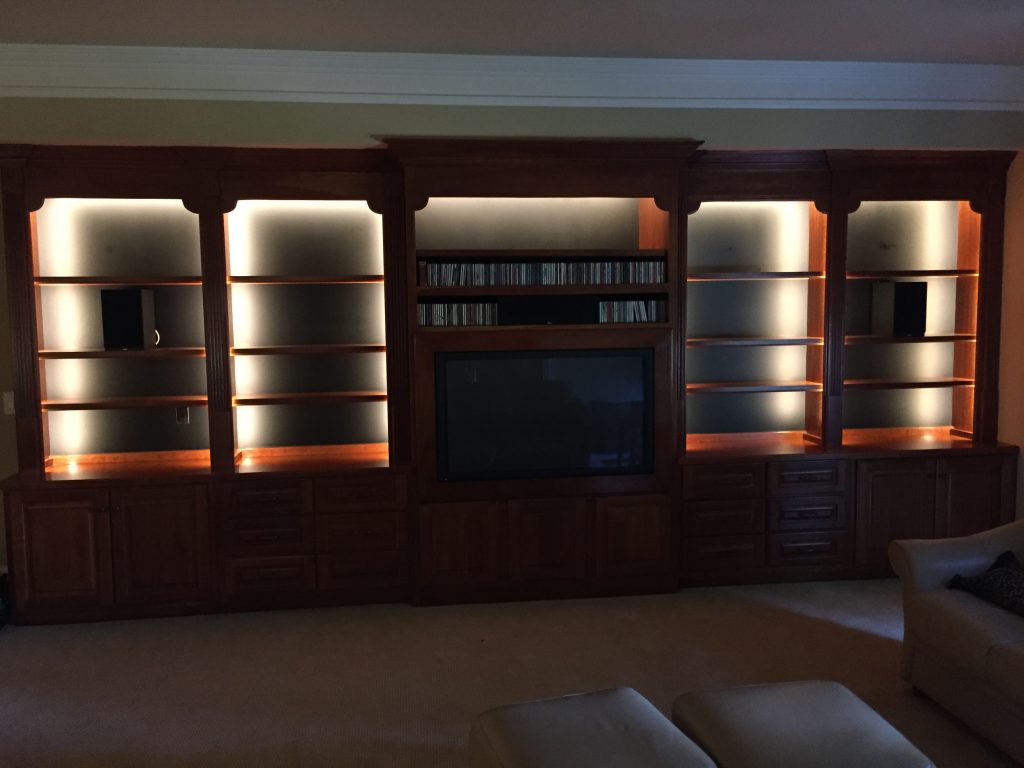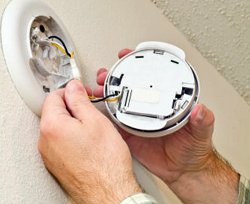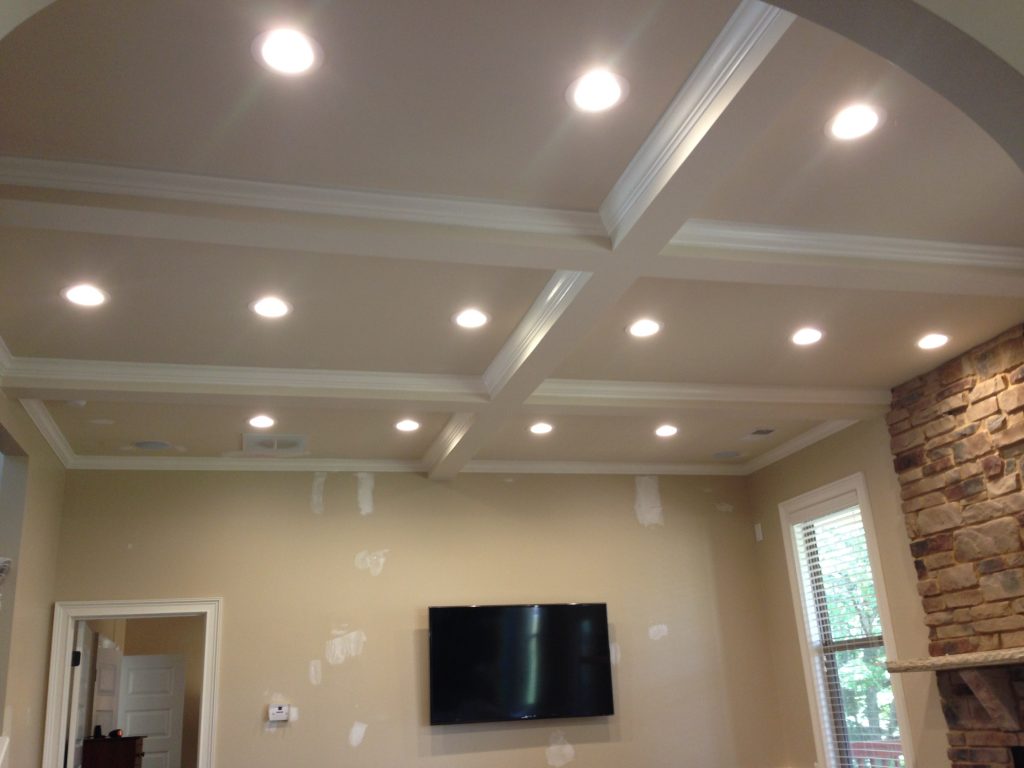Everyone knows that frustration of getting your room decorated just so and then discovering that the outlet is a tiny bit farther than the cord of your lamp.
For those times when the power you need is just out of reach, an extension cord can be the best solution, but you want to make sure that the best solution is the right cord.
The wrong extension or drop cord can create serious problems, up to and including damage to the appliance you’re plugging in. There’s a big difference between running a cord to charge your mobile device or running a cord to fire up your power saw.
We’ve put together some tips to help you make sure you’re using the right cord.
Don’t Bring that Outside
One of the most important considerations when choosing the right extension cord is whether or not it is rated for outdoor use.
A cord not rated for outdoor use can overheat and cause a fire. The packaging on the cord will note whether or not it can be used outside, but a W printed on the cord identifies it as being a cord suited for outdoor use.
Gauge How Much Power You Need
Different extension cords will deliver different amperages, and so you should understand how much power you need to run the appliance.
Most household appliances have a printed amperage rating found on a tag or a plate. Extension cords are categorized by gauge (with most household cords falling between 18 gauge and 8 gauge (lower gauges corresponding to heavier duty appliances).
Using the right gauge with the right appliance is important. If you have questions, you can always consult an extension cord amperage chart.
Don’t Extend Too Far
Voltage levels can drop as electricity travels through longer extension cords, so it’s important to use a cord that is only as long as you need it to be. Using cords that are too long also wastes electricity.
The open flames on the menorah illuminate the dark living room. Kinaras, red and green, fill homes with the spirits of unity and peace; green pine trees, living and manufactured, display sharp blues, effervescent greens, and joyful reds through their tiny light bulbs. It is the month of peace and goodwill, and these symbolic lights of love should not end in a tragic and destructive blaze. Read the following Christmas light safety tips to ensure you protect your home and family this holiday season.
According to statistics from the National Fire Protection Association, an average of 210 homes are set on fire every year. These fires between 2010 and 2014 caused 16 civilian injuries, 6 civilian deaths, and an estimated 16.2 million dollars in property damage.
Although Christmas tree lighting is a fairly uncommon way to accidentally start a fire, these particular fires tend to be more costly and more deadly. The emotional impact of having a Christmas tree set ablaze expensive presents, dolls, toy trains, is a memory not soon forgotten. To avoid that level of both severe property and emotional damage, there are a few inexpensive tricks to making certain your tree stays a symbol of giving and love instead of a costly blazing burden.
Prevent Your Tree from Drying Out
First, always make certain that live Christmas trees are fresh. Look for the pine needles to be a fresh green color, and steer clear of trees that have obvious signs of age and rotting like brown needles. Trees that are dried out are much more flammable. To prevent your tree from drying out, water it daily.
Use Flame-Retardant Lights
 Next, choose Christmas tree lights that are flame-retardant. This is always easily located on the manufacturer’s label of the tree. The manufacturer’s label should state if the testing was done by a reputable laboratory like Intertek, The Canadian Standards Association, or the Consumer Products Safety Commission.
Next, choose Christmas tree lights that are flame-retardant. This is always easily located on the manufacturer’s label of the tree. The manufacturer’s label should state if the testing was done by a reputable laboratory like Intertek, The Canadian Standards Association, or the Consumer Products Safety Commission.
Keep Your Tree Away From Heat
After ensuring that your tree lights will not cause you an unnecessary burden, make sure that you put your illuminated tree at least three feet away from the nearest source of heat. Heat sources are not just fireplaces. In addition to fireplaces, your tree should be at least three feet away from lamps, dryers, space heaters, and heating vents.
Christmas lights are a beautiful way to brighten the spirits of even the darkest homes. And they should shine that way all season, free from any life-threatening flames. Stay safe!
There are many safety precautions to consider when you have a baby in the house, including electrical outlets. Electronics are a great part of our daily lives, but unfortunately, most are not designed with children’s safety in mind. Though you most likely can’t avoid utilizing them in your home, you can take the necessary steps to make electrical outlets and receptacles as safe as possible for your loved ones.
Importance of Baby-Proof Outlets
Babies love putting objects into electrical outlets. They see you plugging something in and want to do the same. An outlet becomes a new toy for a baby, but this is very dangerous. Keys, paper clips, knives, hair pins, and jewelry are just a few examples of the many common items children poke into electrical outlets. If your baby puts something in an outlet, they are at serious risk for an electrical shock.
Every year, approximately 2,400 children are treated for shocks and burns related to tampering with electrical outlets. That’s about 7 children every day. Even more troubling, about 12 children die from these injuries each year. Baby-proofing your electrical outlets is so important, it could save your child’s life.
How to Baby-proof Your Electrical Outlets
Though parental supervision is the best form of baby-proofing, there are several ways to ensure your baby’s safety around electronics. But first, you must determine what kind of receptacles you have.
Receptacles are behind the outlet cover. They are the mechanisms that electrical wires screw into. In regular receptacles, the slots are open holes, making it very tempting for a young one to play with. Tamper-resistant receptacles contain spring-loaded shutters on their receptacles that must be pushed simultaneously to open. This is an obvious advantage, so obtaining tamper-resistant receptacles is the first step in baby-proofing your outlets.
Next, you should identify whether you have standard outlets or Decora style outlets. This will determine what products will fit onto your outlets. The difference is in the way the outlet cover attaches to the receptacle: standard outlets use a screw and the Decora style covers clip onto the receptacle.
Outlet Caps
These are great for outlets that aren’t frequently used. They are simply plastic covers that plug directly into the outlet. The front is flat, making it difficult for a baby to pull it out of the outlet.
Safe-Plate Slide Covers
These are baby-proof outlet covers that replace your existing one. Safe plate slide covers have spring-loaded shutters that cover the holes in the sockets completely. To plug something in, place the prongs into the cover and slide it across to reach the actual outlet.
Complete Outlet Covers
There are also devices that cover the entire outlet in a cage-like manner. This will not only prevent your baby from reaching the outlet, but it will also prevent them from unplugging any cords.
Baby-proofing your electrical outlets is very important. No matter which method you choose, it will keep your family safe and ensure your peace of mind.
By all means, replace all the light bulbs, and light fixtures to your heart’s content. As for any re-wiring or other serious electrical work, it is best to seek out a professional. This way you can ensure the safety of you and your loved ones. For the long-term integrity and reliability of your home contact the professionals at Socket Doctors today.
With the advent of social media channels like YouTube and Viemo, taking on DIY or Do-It-Yourself projects has never been easier. Undertaking a DIY project is a great money saving option for homeowners who want to fix problems in their home or simply improve its value. However, there are particular repairs like electrical work, that you are better off leaving to the professionals. With something like electrical wiring, the cost of hiring an electrician from the beginning is more cost effective than having one come in after the fact. It is a known fact that DIY’ers who undertake electrical home improvement projects seldomly walk away with a positive experience. Here are some reason why:
There’s a “Code”
Unless you are ready to read all 644 Codes and Standards by the National Electric Code, chances are your handiwork will not be up to par. Every single aspect of electrical work is regulated by very strict codes –from the nuts and bolts to the wires. What does this mean? If you carry out your DIY electrical project and something goes wrong — for instance, a fire or any other damage– your home insurance is rendered invalid.
In other words, you are not covered for any damage incurred as a direct result of your handiwork. Your insurance company may also place you in the high-risk category, which can result in higher rates. In the long run, the DIY risk you are taking could come with a hefty bill.
The Experienced Eye
Not all contractors are the same, same goes for electricians. When you hire a qualified electrician, you’re also hiring their experience. Here is why this is important. In some unfortunate cases, electrical wiring is poorly done — to no fault of your own — a trained and experienced electrician cannot only quickly spot any unforeseen problems; but they can also attribute the proper solutions. The last thing you want is to knowingly put yourself in harms ways. This leads us to our next reason why it is better to leave it to the professionals.
Danger!
The most important reason you should not DIY your electrical repairs is because it is very dangerous. According to the National Electrical Manufacturer’s Association, in the United States, the annual cost of damages sustained by electrical fires totals $3.4 billion per year. Not only can you accidentally electrocute yourself or others, you might set your house on fire. Both of these reasons could result in fatality or serious injury. Simply put, any monetary savings are not worth it.
By all means, replace all the light bulbs, and light fixtures to your heart’s content. As for any re-wiring or other serious electrical work, it is best to seek out a professional. This way you can ensure the safety of you and your loved ones. For the long-term integrity and reliability of your home contact the professionals at Socket Doctors today.
Installing recessed lighting is a great way to add style and elegant lighting to any room. But with so many different trim options and housing sizes, it can be difficult to determine what kind of recessed lighting will work best for what you’re trying to accomplish. This guide will explain the various options available so that you can decide which will work best for you.
Recessed Lighting Housing Options
The housing is the light fixture itself. It’s what sits inside the ceiling and what holds the trim along with the light bulb. Housing comes in different sizes ranging from 3 to 6 inches in diameter. Below are the various kinds of housing you can pick up.
- New construction housing is used before the ceiling is installed.
- Remodel housing is used when you have an existing ceiling.
- Insulation Contact (IC) housing is used when installing recessed lighting in insulated portions of the house. Installing non-IC housingnear insulation is a major fire hazard. Non-IC housing should only be used when there’s at least 3 inches of space between the housing and the insulation.
- Airtight housing reduces the airflow between the space above and the room below.
- Shallow ceiling housing is used when dealing with ceilings with 2-inch by 6-inch joists.
- Slope ceiling housing is used for angled ceilings.
Recessed Lighting Trim Options
The trim is what fits inside the housing and forms the fixture’s outer ring, giving your recessed lighting the look you want.
- Baffle trim is designed to diffuse and absorb excess light so that it’s more evenly distributed. It also helps to reduce glare, making them great for living rooms, dining rooms, dens, and bedrooms.
- Reflector trim helps to maximize the amount of light produced. They also help to obscure the bulb from view and prevent warming. Reflector trim is great for kitchens and high ceilings.
- Eyeball/Adjustable trim allows you to focus the light where you want it. This makes them great for highlighting accent walls or other decorative features.
- Lensed trims are meant to keep moister out of the housing. This makes them the preferred choice for bathrooms and showers.
- Wall wash trim shields most of the bulb to evenly focus light on a specific feature. This could be a fireplace or a piece of art.
- Decorative trims give you the ability to customize the look of your recessed lighting so it can match the style of the room.
Recessed Lighting Bulb Options
- Incandescents are the cheapest light bulbs you can buy, only running about $1 a piece. They last for roughly 2 to 3 years and uses 60-65 watts of electricity, making them not very efficient.
- Halogens sell for roughly $2 and are much brighter than incandescents. However, they do throw off a lot of heat. Their lifespan is the shortest at about 1 to 2 years and they use about 43-50 watts.
- Compact fluorescent bulbs are higher priced than halogens and incandescents but are still very affordable at $2-4 a piece. They last roughly 5 to 7 years and only use 13-15 watts.
- LEDs are the most efficient bulbs, only using 9-12 watts. They also last the longest at 15 years or more. Prices range from $2-5 a piece, so they’re still very affordable. Plus with the extended lifespan, they’re definitely worth the extra money.
Hopefully now you’ll be able to narrow down which recessed lighting options will work best for you. Remember that Socket Doctors is always here to help with your recessed lighting installation and design.
To have the best experience when you watch movies or listen to music you need an expertly installed home theater system. To install a great home theater system, you must have a solid grasp of visual and audio components and how they work. A professional installer has the ability to assess your home’s capabilities and suggest what will allow you to have optimal performance from your home theater system.
Acoustics, seating views, and lighting must all be taken into account when setting up your home entertainment systems. Many homeowners are sure that they are able to install home entertainment systems, but it’s never as easy as it seems. It can actually be quite difficult and sometimes even a little dangerous. It’s best to leave tasks like this to professionals.
Let Experience Work

A lot of experience and know-how go into high quality visual and audio setup and display. If the components of your system are installed properly and adjusted for the acoustics in the room, you’ll see and hear some of the purest forms of entertainment available on the market today. If you choose to do it yourself it may sound good, but it is unlikely it will be optimized for near perfection. Choosing where to install surround sound speaker, monitors, TV projectors, and hidden wires can make a huge difference in your experience in your man cave, living room, or bedroom.
Relax and Let the Experts Do Their Job
The main reason to have your home theater installed professionally is simply so you don’t have to deal with it. It takes a lot of energy, planning, expertise, and patience to set up a home entertainment system. No thanks. The price you pay for professional installation will pale in comparison to the stress of trying to do it all yourself. This can be compounded if you’ve got quite a few components and more intricate setup planned.
Try to avoid stress whenever you can, don’t doctors say that? DIY installation leads to frustration; frustration leads to stress; stress leads to potential physiological issues. All joking aside, having your entertainment system installed by expert technicians will allow you to relax while the professionals get the job done right the first time. After installation, you can ask any questions you may have regarding your system and go over the functions of everything.
Peace of Mind
Keep in mind that you’re not hiring a contractor, you’re hiring an expert installer. Anyone who’s done construction or even interned for a summer can hide wires from your TV to your surround sound system. It takes an expert to make sure you’re using the cables and wires that will best optimize picture and sound. An expert also gives you a leg up on the contracting crowd because when they evaluate your entertainment space for your home theater, they take into account all factors that will affect sound and viewing.
To get the most out of your home theater system, be sure to have it installed and set up by licensed and insured professionals. They’ll guarantee their work and you won’t be held responsible should something go awry.
 Smoke Detectors become faulty or unresponsive:
Smoke Detectors become faulty or unresponsive:
- Manufacturers recommend replacing smoke detectors every 7-10 years to ensure proper functionality.
- Just like your light fixtures, air filters and vents collect dust, your smoke detectors are prone to buildup as well.
- Dust causes the sensors inside of units to be blocked, preventing them form sensing smoke.
- All homes need 110 volt battery backup smoke detectors. Older homes do not have them, but they can be added easily with zero damage to the walls. There is also a wireless smoke detector that sends a signal to all the other smoke detectors in your home. If one goes off, they all go off.
Assessing the need for Carbon Monoxide/Smoke Detectors:
- Most homes are heated by a gas furnace, have a wood/gas burning fireplace and a gas water heater.
- Most homes also do not have a single carbon monoxide detector.
- There are carbon monoxide/smoke detector combos that replace your standard smoke detector, giving you the ability to have a carbon monoxide detector in key areas of the home.
- These detectors also have a female voice that alerts of smoke, carbon monoxide, or low batteries. The voice has two major benefits over the standard beeps in a normal smoke detector.
- A test has shown, while sleeping, more people wake up to a voice rather than a beeping noise.
- The voice also identifies whether smoke or carbon monoxide has been detected, or if you just have a low battery. No need to try and figure out whether it is beeping 3 times or 4 times.
Being a homeowner is a wonderful thing. Doing things yourself has become your go-to activity in the evenings and on weekends. You replaced that shower cartridge and stopped that leaky showerhead. You and your kids took on the floor replacement in your kitchen and it looks fantastic. Now, your wife has come home from the hardware store and has new light fixtures. You’re going to go straight to YouTube and figure out how to get those things installed, right? Wait a minute. That means you have to deal with electricity. Well, maybe you’re not so sure that you want to do that anymore.
You feel that way for a good reason. Electricity should be left to the professionals! For those of you reading this that have installed your own fixtures and such, kudos to you. Unless of course you’ve had issues with your devices since their being installed. Does that sound familiar?
When you flip the switch for the new light fixture in your dining room does it take a second or two for the light to come on? Does it make a weird sound when it comes on? Are the lights intermittently flickering or dimming? Do any of your lights buzz, vibrate or hum when on? If you’re lighting is experiencing any of these problems, there’s a fair to good chance that faulty wiring is to blame. Get help NOW! Electricity is a dangerous mistress and a typical homeowner should not try to tame her. Contact an electrician to help with any electrical issues you might have.
Another sign of bad wiring is charred or scorched marks around your wall outlets. Even if they don’t make any weird noises or spark, you could still have bad wiring. When your home was built the electricians who installed all of the outlets were likely licensed and very aware of the code with which the outlets had to be installed. However, if you’re in an older home, the wires that were probably grounded when installed may have come disconnected or rotted by now.
Leave Electrical Problems to the Experts
You really don’t want to mess with electricity. It sounds cool, but it’s only fun for people who know exactly what they’re doing. For those needs, you should call professional electricians like the ones at Socket Doctors. No job is too small or too big for these Master Electricians. From ceiling fan installations to complete rewiring of electrical grids, they really are the masters of electricity.

